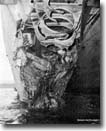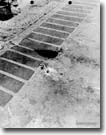



If you can see this text here you should update to a newer web browser
Normal | Highlight & Comment Highlighted Text will be in Yellow, but there are none yet
|
RESTRICTED
1. On 15 September 1942, a submarine torpedo detonated against the port side of O'BRIEN between the stem and frame 6 and about 10 feet below the waterline. The resulting local structural damage is shown in Photos 32 and 33 and Plate 17. The bow structure, below the main deck and aft to Frame 10 was blown away. Framing and plating were distorted back to frame 14. Free flooding occurred below the first platform between frames 10 and 22. As the bow plunged into sea, compartment A-202L on the first platform flooded slowly to a depth of 2 feet through ruptures in the first platform and bulkhead 14. Bulkhead 22 bulged aft but remained tight. Bulkhead 25 was not damaged. The draft forward, which was 11' 7" before damage, increased to 12' 2". This damage in itself was not serious and would not have placed the vessel in jeopardy. 2. The explosion also caused severe flexural vibration of the hull girder. Photos 34 and 35 and Plate 17 show some of the moderate buckling of hull plating and longitudinals which resulted near frames 37, 78 and 123. The most serious failures were in the bottom structure between frames 104 and 108. Wrinkling and buckling of the shell and longitudinals extended from frame 104, starboard, across the bottom to frame 108, port. In this region the vertical keel, No. 2 and 6 deep longitudinals, several smaller longitudinals and shell plating all failed to some degree. Thus, the entire bottom flange of the ship girder was seriously damaged. In this area many rivets were loosened or sheared. There was considerable leakage through rivet holes and open seams into the forward engine room. Gun roller path data indicated that the after portion of the ship was twisted 1° to port. 3. While damage control measures were being undertaken, O'BRIEN proceeded under her own power at r.p.m. for 13 knots to Espiritu Santos, a distance of 280 miles. During passage, wind and sea were moderate with little or no swell, and maximum speed over the ground was estimated at 12 knots. 0'BRIEN went alongside CURTISS (AV 4) at
|
|
RESTRICTED
Espiritu Santos on 16 September. The following repairs were made by 0'BRIEN, CURTISS and the 7th Construction Battalion.
4. 0'BRIEN departed Espiritu Santos on 21 September and proceeded at a maximum speed of 11.5 knots to Noumea, a distance of 603 miles, arriving there on 23 September. During passage wind and sea did not exceed moderate intensity. During both passages 0'BRIEN rode easily. Although regular inspections were made, no working of the two parts of the ship were observed. Repairs to the bottom, which were made in Espiritu Santos, reduced leakage into the forward engine room so that it could be controlled by one fire and bilge pump; whereas, the main circulating pump, operating at near capacity, had been required to control the leakage before arrival at Espiritu Santos. 5. At Noumea, ARGONNE (AG 31) made further temporary repairs:
|
||||||||||||||||||||||||||||||||||||
|
6. Upon completion of repairs at Noumea, 0'BRIEN was considered capable of making 15 knots in a moderate sea. On 10 October, 0'BRIEN in company with CIMMARON (AO 22) and LANG (DD 399) departed for Mare Island. After getting underway, a slight increase in the rate of leakage into the forward engine room was observed. This was not considered abnormal because of the many patches and loose rivets in the bottom. As a precautionary measure, the ship's force attempted to compare the bending across the damaged section with that across an undamaged section of similar length in the after engine room. The observed deflections were nearly identical.. In view of the difficulty of obtaining reliable hull deflection readings at sea, these efforts probably were of no value. Shortly before arrival at Suva, a distance of 862 miles, on the morning of 13 October, the reinforcing plate installed on
|
||||||||||||||||||||||||||||||||||||||
|
No. 6 port longitudinal was found to have failed in tension. During this passage wind and sea did not exceed moderate intensity, and turns for 13 knots resulted in a ground speed of 12 knots. 7. At Suva, an angle was welded to the broken reinforcing plate. The damage and repairs throughout the ship were inspected thoroughly. No other indications of increased damage or weakening of the repairs were observed. At 1430, 16 October, 0'BRIEN joined CIMARRON and LANG in the outer harbor. When the ship reached the open sea, leakage into the forward engine room again increased to about the rate previously experienced under similar sea conditions. One fire and bilge pump, operating slowly, controlled the leakage. 8. After leaving Suva, 0'BRIEN crossed the international date line and 16 October was repeated. By early morning of 18 October, the rate of leakage had increased to the extent that one fire and bilge pump was required to control it. At 0500, 18 October, a second fire and bilge pump was started so that each might run at low speed. Inspection revealed that the reinforcement of No. 6 port longitudinal again had cracked in the same place as before. Just outboard of this longitudinal the shell plating had a 3 inch crack along a wrinkle. The rate of leakage continued to increase so that at 0900 the two fire and bilge pumps were secured and the main circulating pump was started. About 1000, the vertical keel was found to be completely broken and cracks were developing in the other deep longitudinals and in the shell plating. Course was changed to Pago Pago and to pass Upolo close aboard. 9. The ship's force undertook various precautionary measures to meet emergency conditions, including jettisoning topside weights, assembling the crew for instruction, arranging communication signals, reducing free surface in fuel tanks, etc. Throughout the remainder of the day and night, the rate of leakage into the forward engine room continued to increase, but still could be controlled by the available pumping facilities. At 0337, a shell plate on the port side behind the dynamo condenser broke with a loud noise and the water level rose slowly even after full pumping facilities were used. At 0430 it was necessary to abandon the forward engine room. At 0600 the bottom suddenly opened considerably and the forward and after portions of the hull began to work independently. At 0605 the starboard side cracked open up to the main deck. The ship was abandoned at 0630, and sank about 0800, having steamed 1027 miles from Suva and about 2800 miles after having been torpedoed.
|
|
10. Because complete details of the damage are not available, calculations of the structural condition of the ship have been made on the basis of the damage reported by the Commanding Officer. In calculating the condition of the ship after damage, it has been assumed that none of the damaged structure remained effective. Since some of the damaged structure undoubtedly remained partially effective, the actual section moduli probably are greater than indicated. In calculating the condition of the ship after repairs, it was assumed that all reinforcing members are fully effective. The variables involved in calculations of this type preclude accurate estimates, therefore, the results should be considered as changes which might have occurred rather than precise data as to what actually occurred. They serve to present the order of magnitude of the changes in strength of the ship girder.
11. Failure of the bottom structure was progressive up to 0600, 18 October. Stress concentrations undoubtedly occurred in the lower edges of the reinforcing girders and caused failure of some of them. Failure of the previously damaged structure followed. This progressive failure is evident in the repeated failure of No. 6 port longitudinal reinforcing section, the small crack in the port shell at 0500, 18 October, the crack in the keel at 1000, 18 October, and the constantly increasing rate of leakage into the engine room. Tensile stress in the remaining structure must have increased as the engine room flooded, and additional failures probably occurred
|
||||||||||||||||||||||||||||||||||||||||||||||
|
during this time. The hull split up to the main deck shortly after the engine room flooded to the waterline, putting the ship in an extreme sagging condition. The main deck, starboard, started to rupture but did not fail completely. 12. 0'BRIEN was lost because the repairs to the ship girder did not restore adequate longitudinal strength. Deficiencies in the repairs are:
|
||||||||||
SOURCE:
Transcribed by RESEARCHER @ LARGE. Formatting & Comments Copyright R@L.
O'Brien Home | Repairs in Forward Areas Home |
Ships Home | Researcher@Large Home